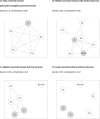Information exchange networks for chronic diseases in primary care practices in Germany: a cross-sectional study
- PMID: 35346050
- PMCID: PMC8958478
- DOI: 10.1186/s12875-022-01649-3
Information exchange networks for chronic diseases in primary care practices in Germany: a cross-sectional study
Abstract
Background: Coordination of care requires information exchange between health workers. The structure of their information exchange networks may influence the quality and efficiency of healthcare delivery. The aim of this study was to explore and classify information exchange networks in primary care for patients with chronic diseases in Germany.
Methods: A cross-sectional study was carried out between 2019 and 2021. As part of a larger project on coordination of care, this study focused on information exchange in practice teams regarding patients with type 2 diabetes (DM), coronary heart disease (CHD) and chronic heart failure (CHF). Social network analysis was applied to determine the number of connections, density and centralization for each of the health conditions for each of the practices. On the basis of the descriptive findings, we developed typologies of information exchange networks in primary care practices.
Results: We included 153 health workers from 40 practices, of which 25 practices were included in the social network analysis. Four types of information exchange structures were identified for the three chronic diseases: highly connected networks with low hierarchy, medium connected networks with medium hierarchy, medium connected networks with low hierarchy and lowly connected networks. Highly connected networks with low hierarchy were identified most frequently (18 networks for DM, 17 for CHD and 14 for CHF). Of the three chronic conditions, information sharing about patients with DM involved the most team members. Information exchange outside the family practice took place mainly with nurses and pharmacists.
Conclusions: This study identified four types of information exchange structures, which provides a practical tool for management and improvement in primary care. Some practices had few information transfer connections and could hardly be considered a network.
Trial registration: We registered the study prospectively on 7 November 2019 at the German Clinical Trials Register (DRKS, www.drks.de ) under ID no. DRKS00019219.
Keywords: Chronic diseases; General practice; Information exchange networks; Social network analysis.
© 2022. The Author(s).
Conflict of interest statement
The authors declare that they have no competing interests.
Figures

Similar articles
-
Cooperation networks of ambulatory health care providers: exploration of mechanisms that influence coordination and uptake of recommended cardiovascular care (ExKoCare): a mixed-methods study protocol.BMC Fam Pract. 2020 Aug 16;21(1):168. doi: 10.1186/s12875-020-01229-3. BMC Fam Pract. 2020. PMID: 32799795 Free PMC article.
-
Patient-reported continuity of care and the association with patient experience of cardiovascular prevention: an observational study in Germany.BMC Prim Care. 2022 Jul 18;23(1):176. doi: 10.1186/s12875-022-01788-7. BMC Prim Care. 2022. PMID: 35850657 Free PMC article.
-
Information exchange networks for chronic illness care in primary care practices: an observational study.Implement Sci. 2010 Jan 22;5:3. doi: 10.1186/1748-5908-5-3. Implement Sci. 2010. PMID: 20205758 Free PMC article.
-
[A systematic review on population-based indicators of the quality of care in formal and informal provider networks and their application in health economic evaluations].Z Evid Fortbild Qual Gesundhwes. 2019 Aug;144-145:7-23. doi: 10.1016/j.zefq.2019.06.004. Epub 2019 Jul 19. Z Evid Fortbild Qual Gesundhwes. 2019. PMID: 31327735 German.
-
Social networks in health care teams: evidence from the United States.J Health Organ Manag. 2016 Oct 10;30(7):1119-1139. doi: 10.1108/JHOM-12-2015-0201. J Health Organ Manag. 2016. PMID: 27700473 Review.
Cited by
-
Influence of Cooperation Work on Management Continuity of Ambulatory Cardiovascular Care: A Cross-Sectional Exploratory Study in Germany.Int J Integr Care. 2023 Dec 6;23(4):14. doi: 10.5334/ijic.7019. eCollection 2023 Oct-Dec. Int J Integr Care. 2023. PMID: 38074514 Free PMC article.
References
-
- World Health Organization . World health statistics 2020: monitoring health for the SDGs, sustainable development goals. 2020.
Publication types
MeSH terms
LinkOut - more resources
Full Text Sources
Medical
Research Materials
